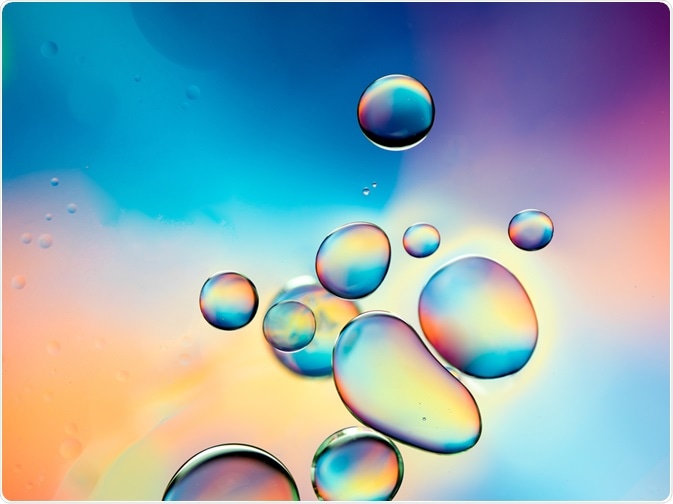Surface science is the study of the physicochemical properties that occur at the interface of two phases, which include solid-liquid, solid-gas, liquid-gas, and solid–vacuum interfaces. Both chemistry and physics attempt to understand these surface interactions.

Image Credit: Comaniciu Dan/Shutterstock.com
Surface science
Surface chemistry investigates chemical reactions occurring at interfaces. By modifying the chemical composition of a surface through the addition of certain elements and molecules, it can change the properties of the interface, which can be used for specific applications. Some applications are found in the fields of catalysis, electrochemistry, and geochemistry.
In contrast, surface physics, while closely related to surface chemistry, investigates physical interactions that occur at interfaces. Some subjects investigated include surface phonons and plasmons, surface states, friction, surface diffusion, and nanostructures on surfaces.
Applications in surface science
Some fields of research in surface chemistry include the investigation of surface adhesion by gas or liquid. Understanding the surface adsorption of catalysts is especially important because it affects their performance. However, investigating complex catalytic structures is often difficult. Hence, model catalysts tend to be used, such as platinum, to study interactions between their metal surfaces and other molecules.
Electrochemistry is another application in surface chemistry, which studies surface interfaces subjected to electrical potential. The concentration and spread of ions in the liquid phase can influence the behavior of an electrode-electrolyte interface.
Additionally, applications in geochemistry utilize surface chemistry in the field of soil science by controlling interfaces between minerals and their environment. Studies of heavy metal adsorption onto mineral surfaces at the molecular scale enable accurate predictions of these contaminants in soils.
Techniques for analysis
Typically, both physical and chemical analysis techniques are used to study surfaces. Techniques for analyzing adsorption onto surfaces for the above surface chemistry applications can be studied using spectroscopy, scanning probe microscopy, and X-ray scattering.
Several modern techniques probes <10 nm of surfaces exposed to vacuum. These include thermal desorption spectroscopy (TPD), low-energy electron diffraction (LEED), ion scattering spectroscopy (ISS), secondary ion mass spectrometry, Angle-resolved photoemission spectroscopy (ARPES), X-ray photoelectron spectroscopy (XPS), Auger electron spectroscopy (AES), electron energy loss spectroscopy (EELS) and dual-polarization interferometry to name a few.
A key requirement to many of these techniques is that they need vacuum because they rely on the detection of ions or electrons emitted from the surface. However, for ultra-high vacuum techniques in the range of 10 – 8 pascal pressure, surface contamination by residual gas needs to be reduced.
Certain optical techniques can also be used to study interfaces under certain conditions. Surface-enhanced Raman spectroscopy and infrared spectroscopy can probe solid–vacuum as well as solid-gas, solid-liquid, and liquid–gas surfaces. Surface plasmon resonance can detect sub-nanometer layers in solid-gas, solid-liquid, liquid–gas surfaces. Dual-polarization interferometry is used to quantify the order and disruption in thin films and has been used to understand the formation of lipid bilayers and their interaction with membrane proteins.
X-ray scattering and spectroscopy techniques are also used to characterize surfaces. X-ray standing wave (XSW) measurements investigate surface structure changes with sub-Ångström resolution. The coordination structure and chemical state of adsorbates can be understood using surface-extended X-ray absorption fine structure (SEXAFS) measurements.
Additionally, the size, morphology, and orientation of nanoparticles on surfaces can further be understood using grazing-incidence small-angle X-ray scattering (GISAXS). The crystal structure of thin films can be studied using grazing-incidence X-ray diffraction (GIXD, GIXRD).
Finally, techniques such as scanning-tunneling microscopy (STM) and their derivatives, including atomic force microscopy (AFM) are physical analysis methods used in the field of surface science. These microscopy techniques have allowed researchers to measure the physical structure of a variety of surfaces, including solid-gas interfaces.
Sources:
- Fischer-Wolfarth, Jan-Henrik; Farmer, Jason A.; Flores-Camacho, J. Manuel; Genest, Alexander; Yudanov, Ilya V.; Rösch, Notker; Campbell, Charles T.; Schauermann, Swetlana; Freund, Hans-Joachim (2010). "Particle-size dependent heats of adsorption of CO on supported Pd nanoparticles as measured with a single-crystal microcalorimeter". Physical Review B. 81 (24): 241416.
- Gewirth, Andrew A.; Niece, Brian K. (1997). "Electrochemical Applications ofin Situ Scanning Probe Microscopy". Chemical Reviews. 97 (4): 1129–1162.
- Nagy, Zoltán; You, Hoydoo (2002). "Applications of surface X-ray scattering to electrochemistry problems". Electrochimica Acta. 47 (19): 3037–3055.
- Gründer, Yvonne; Lucas, Christopher A. (2016-11-01). "Surface X-ray diffraction studies of single crystal electrocatalysts". Nano Energy. 29: 378–393.
- Catalano, Jeffrey G.; Park, Changyong; Fenter, Paul; Zhang, Zhan (2008). "Simultaneous inner- and outer-sphere arsenate adsorption on corundum and hematite". Geochimica et Cosmochimica Acta. 72 (8): 1986–2004.
- Xu, Man; Kovarik, Libor; Arey, Bruce W.; Felmy, Andrew R.; Rosso, Kevin M.; Kerisit, Sebastien (2014). "Kinetics and mechanisms of cadmium carbonate heteroepitaxial growth at the calcite surface". Geochimica et Cosmochimica Acta. 134: 221–233.
- Jussila, Henri; Yang, He; Granqvist, Niko; Sun, Zhipei (5 February 2016). "Surface plasmon resonance for characterization of large-area atomic-layer graphene film". Optica. 3 (2): 151
- Mashaghi, A; Swann, M; Popplewell, J; Textor, M; Reimhult, E (2008). "Optical Anisotropy of Supported Lipid Structures Probed by Waveguide Spectroscopy and Its Application to Study of Supported Lipid Bilayer Formation Kinetics". Analytical Chemistry. 80 (10): 3666–76.
- Renaud, Gilles; Lazzari, Rémi; Leroy, Frédéric (2009). "Probing surface and interface morphology with Grazing Incidence Small Angle X-Ray Scattering". Surface Science Reports. 64 (8): 255–380.
- Wintterlin, J.; Völkening, S.; Janssens, T. V. W.; Zambelli, T.; Ertl, G. (1997). "Atomic and Macroscopic Reaction Rates of a Surface-Catalyzed Reaction". Science. 278 (5345): 1931–4.
- Waldmann, T.; et al. (2012). "Oxidation of an Organic Adlayer: A Bird's Eye View". Journal of the American Chemical Society. 134 (21): 8817–8822.
Further Reading